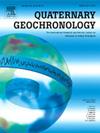Radiocarbon age anomalies in post-impact lake sediments of the Hapcheon impact crater, Korea and their implication for crater evolution
IF 2.5
2区 地球科学
Q3 GEOGRAPHY, PHYSICAL
引用次数: 0
Abstract
Impact craters caused by meteorite collisions are phenomena that dramatically alter the Earth's surface and disturb the natural carbon cycle in subsequent sedimentary environments. To determine the impact date and impact-driven old carbon effects on radiocarbon cycles recorded in post-impact lake sediments, we performed radiocarbon (14C) dating of various organic fractions (humic acids, humins, charcoal, and organic plant fragments of various sizes) in post-impact lake sediments of the Hapcheon impact crater, Korea. Charcoal and plant fragments larger than 500 μm in the post-impact lake sediments of core 20CR09 constituted the oldest fraction (>45,000 cal BP), indicating pre-impact ages. Compared to micro-organic fragments (10–100 μm) consisting of terrestrial plant tissues, pollen, and limited freshwater algae with a narrow age range of 39,300–42,300 cal BP, the 100–500-μm plant fragments showed a slightly older age range of 41,670–43,910 cal BP throughout the 33-m-long lake sediment core. This suggests significant influence of well-mixed syn-impact organic fragments transported from slope deposits consisting of impact breccias and fallback deposits. Humin ages in the lake sediment of core 20CR05 were similar to those of the micro-plant fragments in core 20CR09, indicating that the humin fraction is mainly allochthonous. Humic acids at a depth of ca. 71 m, corresponding to the lowermost post-impact lake sediments (Stage 1), were dated to ∼21,000 cal BP, showing strong influence of post-impact humic acids ages. Whereas those from mid-depth lake sediments (Stage 2) were dated to 35,000–43,000 cal BP. This age reversal indicates increased input of syn-impact allochthonous humic acids, supported by positive correlation with terrestrial mineral input. This study demonstrated significant syn-impact radiocarbon effects and resultant age reversals in post-impact early lake sediments. The syn-impact age may be estimated by comparing ages of different-sized plant fragments (e.g., 10–100, 100–500, and >500 μm), humin, and humic acids. These findings suggest that climatic and environmental interpretations of these post-impact early lake sediments should be conducted only after testing various organic materials, if radiocarbon dating is applied. Lastly, compared to surrounding areas following natural climate changes, post-impact early lake environments in impact craters must be considered as anomalies with different ecosystems due to hydrothermal activity.
韩国陕川陨石坑撞击后湖泊沉积物放射性碳年龄异常及其对陨石坑演化的意义
陨石碰撞造成的撞击坑是一种现象,它极大地改变了地球表面,扰乱了随后沉积环境中的自然碳循环。为了确定撞击日期和撞击驱动的旧碳对撞击后湖泊沉积物中放射性碳循环的影响,我们对韩国Hapcheon撞击坑撞击后湖泊沉积物中的各种有机组分(腐植酸、人类碱、木炭和不同大小的有机植物碎片)进行了放射性碳(14C)测年。20CR09岩心撞击后湖泊沉积物中粒径大于500 μm的木炭和植物碎片构成最古老的组分(> 45000 cal BP),反映了撞击前的年龄。与陆生植物组织、花粉和有限的淡水藻类组成的10 ~ 100 μm的微生物碎屑(年龄范围为39,300 ~ 42,300 cal BP)相比,100 ~ 500 μm的植物碎屑年龄范围略大,为41,670 ~ 43,910 cal BP。这表明,从由冲击角砾岩和回退沉积组成的斜坡沉积物中运移的混合良好的同冲有机碎屑具有重要影响。20CR05岩心湖底沉积物的人类年龄与20CR09岩心微植物碎屑的人类年龄相似,表明人类组分主要是异源的。约71 m深度的腐植酸,对应于撞击后最底部的湖泊沉积物(阶段1),其年代为~ 21,000 cal BP,显示出撞击后腐植酸年龄的强烈影响。而中深湖沉积物(阶段2)的年代为35000 ~ 43000 cal BP。这种年龄反转表明同冲异源腐殖酸输入增加,与陆源矿物输入正相关。该研究表明,在撞击后的早期湖泊沉积物中存在显著的同步撞击放射性碳效应和由此产生的年龄反转。可以通过比较不同大小的植物碎片(如10-100 μm、100-500 μm和>;500 μm)、腐植酸和腐植酸的年龄来估计同冲年龄。这些发现表明,如果采用放射性碳定年法,这些撞击后早期湖泊沉积物的气候和环境解释应该只有在测试了各种有机物质之后才能进行。最后,与自然气候变化后的周边地区相比,由于热液活动,撞击后的早期湖泊环境必须被视为不同生态系统的异常。
本文章由计算机程序翻译,如有差异,请以英文原文为准。
求助全文
约1分钟内获得全文
求助全文
来源期刊

Quaternary Geochronology
地学-地球化学与地球物理
CiteScore
4.40
自引率
22.20%
发文量
130
审稿时长
20 weeks
期刊介绍:
Quaternary Geochronology is an international journal devoted to the publication of the highest-quality, peer-reviewed articles on all aspects of dating methods applicable to the Quaternary Period - the last 2.6 million years of Earth history. Reliable ages are fundamental to place changes in climates, landscapes, flora and fauna - including the evolution and ecological impact of humans - in their correct temporal sequence, and to understand the tempo and mode of geological and biological processes.
 求助内容:
求助内容: 应助结果提醒方式:
应助结果提醒方式:


